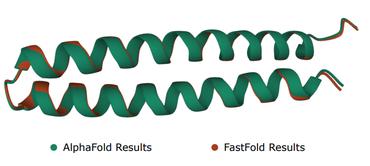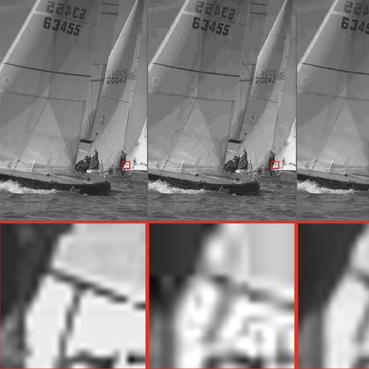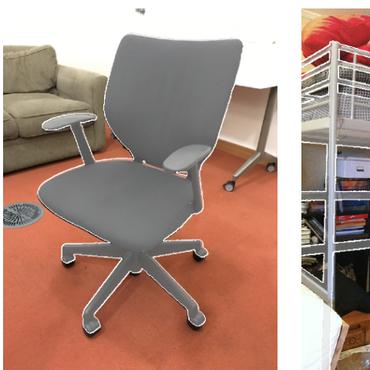Search Results for author: Maks Ovsjanikov
Found 60 papers, 39 papers with code
Self-Supervised Dual Contouring
no code implementations • 28 May 2024 • Ramana Sundararaman, Roman Klokov, Maks Ovsjanikov
Instead of optimizing predicted mesh vertices with supervised training, we use two novel self-supervised loss functions that encourage the consistency between distances to the generated mesh up to the first order.
To Supervise or Not to Supervise: Understanding and Addressing the Key Challenges of 3D Transfer Learning
no code implementations • 26 Mar 2024 • Souhail Hadgi, Lei LI, Maks Ovsjanikov
Unfortunately, its applicability in 3D data processing has been relatively limited.
PoNQ: a Neural QEM-based Mesh Representation
no code implementations • 19 Mar 2024 • Nissim Maruani, Maks Ovsjanikov, Pierre Alliez, Mathieu Desbrun
Although polygon meshes have been a standard representation in geometry processing, their irregular and combinatorial nature hinders their suitability for learning-based applications.
Shape Non-rigid Kinematics (SNK): A Zero-Shot Method for Non-Rigid Shape Matching via Unsupervised Functional Map Regularized Reconstruction
1 code implementation • NeurIPS 2023 • Souhaib Attaiki, Maks Ovsjanikov
We present Shape Non-rigid Kinematics (SNK), a novel zero-shot method for non-rigid shape matching that eliminates the need for extensive training or ground truth data.
Smoothed Graph Contrastive Learning via Seamless Proximity Integration
no code implementations • 23 Feb 2024 • Maysam Behmanesh, Maks Ovsjanikov
Graph contrastive learning (GCL) aligns node representations by classifying node pairs into positives and negatives using a selection process that typically relies on establishing correspondences within two augmented graphs.
Back to 3D: Few-Shot 3D Keypoint Detection with Back-Projected 2D Features
1 code implementation • 29 Nov 2023 • Thomas Wimmer, Peter Wonka, Maks Ovsjanikov
In this work, we propose to explore foundation models for the task of keypoint detection on 3D shapes.
Unsupervised Representation Learning for Diverse Deformable Shape Collections
no code implementations • 27 Oct 2023 • Sara Hahner, Souhaib Attaiki, Jochen Garcke, Maks Ovsjanikov
Unlike previous 3D mesh autoencoders that require meshes to be in a 1-to-1 correspondence, our approach is trained on diverse meshes in an unsupervised manner.
AtomSurf : Surface Representation for Learning on Protein Structures
1 code implementation • 28 Sep 2023 • Vincent Mallet, Souhaib Attaiki, Maks Ovsjanikov
An essential aspect of learning from protein structures is the choice of their representation as a geometric object (be it a grid, graph, or surface), which conditions the associated learning method.
VoroMesh: Learning Watertight Surface Meshes with Voronoi Diagrams
no code implementations • ICCV 2023 • Nissim Maruani, Roman Klokov, Maks Ovsjanikov, Pierre Alliez, Mathieu Desbrun
In stark contrast to the case of images, finding a concise, learnable discrete representation of 3D surfaces remains a challenge.
Spatially and Spectrally Consistent Deep Functional Maps
1 code implementation • ICCV 2023 • Mingze Sun, Shiwei Mao, Puhua Jiang, Maks Ovsjanikov, Ruqi Huang
We first justify that under certain conditions, the learned maps, when represented in the spectral domain, are already cycle consistent.
Zero-Shot 3D Shape Correspondence
no code implementations • 5 Jun 2023 • Ahmed Abdelreheem, Abdelrahman Eldesokey, Maks Ovsjanikov, Peter Wonka
Instead, we propose to exploit the in-context learning capabilities of ChatGPT to generate two different sets of semantic regions for each shape and a semantic mapping between them.
SATR: Zero-Shot Semantic Segmentation of 3D Shapes
no code implementations • ICCV 2023 • Ahmed Abdelreheem, Ivan Skorokhodov, Maks Ovsjanikov, Peter Wonka
We explore the task of zero-shot semantic segmentation of 3D shapes by using large-scale off-the-shelf 2D image recognition models.
Understanding and Improving Features Learned in Deep Functional Maps
no code implementations • CVPR 2023 • Souhaib Attaiki, Maks Ovsjanikov
In this paper, we show that under some mild conditions, the features learned within deep functional map approaches can be used as point-wise descriptors and thus are directly comparable across different shapes, even without the necessity of solving for a functional map at test time.
Generalizable Local Feature Pre-training for Deformable Shape Analysis
1 code implementation • CVPR 2023 • Souhaib Attaiki, Lei LI, Maks Ovsjanikov
We observe that with proper training, learned features can be useful in such tasks, but, crucially, only with an appropriate choice of the receptive field size.
NCP: Neural Correspondence Prior for Effective Unsupervised Shape Matching
1 code implementation • 14 Jan 2023 • Souhaib Attaiki, Maks Ovsjanikov
We present Neural Correspondence Prior (NCP), a new paradigm for computing correspondences between 3D shapes.
TIDE: Time Derivative Diffusion for Deep Learning on Graphs
1 code implementation • 5 Dec 2022 • Maysam Behmanesh, Maximilian Krahn, Maks Ovsjanikov
A prominent paradigm for graph neural networks is based on the message-passing framework.
Equivalence Between SE(3) Equivariant Networks via Steerable Kernels and Group Convolution
no code implementations • 29 Nov 2022 • Adrien Poulenard, Maks Ovsjanikov, Leonidas J. Guibas
Most approaches for equivariance under the Euclidean group $\mathrm{SE}(3)$ of rotations and translations fall within one of the two major categories.
Reduced Representation of Deformation Fields for Effective Non-rigid Shape Matching
1 code implementation • 26 Nov 2022 • Ramana Sundararaman, Riccardo Marin, Emanuele Rodola, Maks Ovsjanikov
In this work we present a novel approach for computing correspondences between non-rigid objects, by exploiting a reduced representation of deformation fields.
Learning Multi-resolution Functional Maps with Spectral Attention for Robust Shape Matching
1 code implementation • 12 Oct 2022 • Lei LI, Nicolas Donati, Maks Ovsjanikov
Our approach is not only accurate with near-isometric input, for which a high spectral resolution is typically preferred, but also robust and able to produce reasonable matching even in the presence of significant non-isometric distortion, which poses great challenges to existing methods.
Smooth Non-Rigid Shape Matching via Effective Dirichlet Energy Optimization
1 code implementation • 5 Oct 2022 • Robin Magnet, Jing Ren, Olga Sorkine-Hornung, Maks Ovsjanikov
We introduce pointwise map smoothness via the Dirichlet energy into the functional map pipeline, and propose an algorithm for optimizing it efficiently, which leads to high-quality results in challenging settings.
Affection: Learning Affective Explanations for Real-World Visual Data
no code implementations • CVPR 2023 • Panos Achlioptas, Maks Ovsjanikov, Leonidas Guibas, Sergey Tulyakov
To embark on this journey, we introduce and share with the research community a large-scale dataset that contains emotional reactions and free-form textual explanations for 85, 007 publicly available images, analyzed by 6, 283 annotators who were asked to indicate and explain how and why they felt in a particular way when observing a specific image, producing a total of 526, 749 responses.
SRFeat: Learning Locally Accurate and Globally Consistent Non-Rigid Shape Correspondence
1 code implementation • 16 Sep 2022 • Lei LI, Souhaib Attaiki, Maks Ovsjanikov
In this work, we present a novel learning-based framework that combines the local accuracy of contrastive learning with the global consistency of geometric approaches, for robust non-rigid matching.
Non-Isometric Shape Matching via Functional Maps on Landmark-Adapted Bases
1 code implementation • 10 May 2022 • Mikhail Panine, Maxime Kirgo, Maks Ovsjanikov
We propose a principled approach for non-isometric landmark-preserving non-rigid shape matching.
Deep Orientation-Aware Functional Maps: Tackling Symmetry Issues in Shape Matching
1 code implementation • CVPR 2022 • Nicolas Donati, Etienne Corman, Maks Ovsjanikov
State-of-the-art fully intrinsic networks for non-rigid shape matching often struggle to disambiguate the symmetries of the shapes leading to unstable correspondence predictions.
Implicit field supervision for robust non-rigid shape matching
1 code implementation • 15 Mar 2022 • Ramana Sundararaman, Gautam Pai, Maks Ovsjanikov
Establishing a correspondence between two non-rigidly deforming shapes is one of the most fundamental problems in visual computing.
Physical Simulation Layer for Accurate 3D Modeling
no code implementations • CVPR 2022 • Mariem Mezghanni, Théo Bodrito, Malika Boulkenafed, Maks Ovsjanikov
We introduce a novel approach for generative 3D modeling that explicitly encourages the physical and thus functional consistency of the generated shapes.
Complex Functional Maps : a Conformal Link Between Tangent Bundles
2 code implementations • 17 Dec 2021 • Nicolas Donati, Etienne Corman, Simone Melzi, Maks Ovsjanikov
In this paper, we introduce complex functional maps, which extend the functional map framework to conformal maps between tangent vector fields on surfaces.
Smoothness and effective regularizations in learned embeddings for shape matching
1 code implementation • 14 Dec 2021 • Riccardo Marin, Souhaib Attaiki, Simone Melzi, Emanuele Rodolà, Maks Ovsjanikov
In this study, we analyze, for the first time, properties that arise in data-driven learned embedding and their relation to the shape-matching task.
Joint Symmetry Detection and Shape Matching for Non-Rigid Point Cloud
no code implementations • 5 Dec 2021 • Abhishek Sharma, Maks Ovsjanikov
Despite the success of deep functional maps in non-rigid 3D shape matching, there exists no learning framework that models both self-symmetry and shape matching simultaneously.
DPFM: Deep Partial Functional Maps
1 code implementation • 19 Oct 2021 • Souhaib Attaiki, Gautam Pai, Maks Ovsjanikov
We consider the problem of computing dense correspondences between non-rigid shapes with potentially significant partiality.
Learning Canonical Embedding for Non-rigid Shape Matching
no code implementations • 6 Oct 2021 • Abhishek Sharma, Maks Ovsjanikov
This paper provides a novel framework that learns canonical embeddings for non-rigid shape matching.
Differentiable Surface Triangulation
1 code implementation • 22 Sep 2021 • Marie-Julie Rakotosaona, Noam Aigerman, Niloy Mitra, Maks Ovsjanikov, Paul Guerrero
Our method builds on the result that any 2D triangulation can be achieved by a suitably perturbed weighted Delaunay triangulation.
WSDesc: Weakly Supervised 3D Local Descriptor Learning for Point Cloud Registration
1 code implementation • 5 Aug 2021 • Lei LI, Hongbo Fu, Maks Ovsjanikov
Instead of using a predefined fixed-size local support in voxelization, we propose to learn the optimal support in a data-driven manner.
Physically-Aware Generative Network for 3D Shape Modeling
no code implementations • CVPR 2021 • Mariem Mezghanni, Malika Boulkenafed, Andre Lieutier, Maks Ovsjanikov
In particular, we introduce a loss and a learning framework that promote two key characteristics of the generated shapes: their connectivity and physical stability.
Fast Sinkhorn Filters: Using Matrix Scaling for Non-Rigid Shape Correspondence With Functional Maps
no code implementations • CVPR 2021 • Gautam Pai, Jing Ren, Simone Melzi, Peter Wonka, Maks Ovsjanikov
In this paper, we provide a theoretical foundation for pointwise map recovery from functional maps and highlight its relation to a range of shape correspondence methods based on spectral alignment.
Learning Spectral Unions of Partial Deformable 3D Shapes
1 code implementation • 31 Mar 2021 • Luca Moschella, Simone Melzi, Luca Cosmo, Filippo Maggioli, Or Litany, Maks Ovsjanikov, Leonidas Guibas, Emanuele Rodolà
Spectral geometric methods have brought revolutionary changes to the field of geometry processing.
Matrix Decomposition on Graphs: A Functional View
no code implementations • 5 Feb 2021 • Abhishek Sharma, Maks Ovsjanikov
We propose a functional view of matrix decomposition problems on graphs such as geometric matrix completion and graph regularized dimensionality reduction.
ArtEmis: Affective Language for Visual Art
3 code implementations • CVPR 2021 • Panos Achlioptas, Maks Ovsjanikov, Kilichbek Haydarov, Mohamed Elhoseiny, Leonidas Guibas
We present a novel large-scale dataset and accompanying machine learning models aimed at providing a detailed understanding of the interplay between visual content, its emotional effect, and explanations for the latter in language.
DWKS: A Local Descriptor of Deformations Between Meshes and Point Clouds
1 code implementation • ICCV 2021 • Robin Magnet, Maks Ovsjanikov
We propose a novel pointwise descriptor, called DWKS, aimed at finding correspondences across two deformable shape collections.
Learning Delaunay Surface Elements for Mesh Reconstruction
1 code implementation • CVPR 2021 • Marie-Julie Rakotosaona, Paul Guerrero, Noam Aigerman, Niloy Mitra, Maks Ovsjanikov
We leverage the properties of 2D Delaunay triangulations to construct a mesh from manifold surface elements.
DiffusionNet: Discretization Agnostic Learning on Surfaces
4 code implementations • 1 Dec 2020 • Nicholas Sharp, Souhaib Attaiki, Keenan Crane, Maks Ovsjanikov
We introduce a new general-purpose approach to deep learning on 3D surfaces, based on the insight that a simple diffusion layer is highly effective for spatial communication.
Weakly Supervised Deep Functional Maps for Shape Matching
1 code implementation • NeurIPS 2020 • Abhishek Sharma, Maks Ovsjanikov
We show empirically the minimum components for obtaining state-of-the-art results with different loss functions, supervised as well as unsupervised.
Correspondence Learning via Linearly-invariant Embedding
2 code implementations • NeurIPS 2020 • Riccardo Marin, Marie-Julie Rakotosaona, Simone Melzi, Maks Ovsjanikov
However, instead of using the Laplace-Beltrami eigenfunctions as done in virtually all previous works in this domain, we demonstrate that learning the basis from data can both improve robustness and lead to better accuracy in challenging settings.
 Ranked #7 on
3D Dense Shape Correspondence
on SHREC'19
(using extra training data)
Ranked #7 on
3D Dense Shape Correspondence
on SHREC'19
(using extra training data)
Geometric Matrix Completion: A Functional View
1 code implementation • 29 Sep 2020 • Abhishek Sharma, Maks Ovsjanikov
We propose a totally functional view of geometric matrix completion problem.
Weakly Supervised Deep Functional Map for Shape Matching
2 code implementations • 28 Sep 2020 • Abhishek Sharma, Maks Ovsjanikov
We show empirically minimum components for obtaining state of the art results with different loss functions, supervised as well as unsupervised.
PointTriNet: Learned Triangulation of 3D Point Sets
1 code implementation • ECCV 2020 • Nicholas Sharp, Maks Ovsjanikov
This work considers a new task in geometric deep learning: generating a triangulation among a set of points in 3D space.
Intrinsic Point Cloud Interpolation via Dual Latent Space Navigation
1 code implementation • ECCV 2020 • Marie-Julie Rakotosaona, Maks Ovsjanikov
We present a learning-based method for interpolating and manipulating 3D shapes represented as point clouds, that is explicitly designed to preserve intrinsic shape properties.
Deep Geometric Functional Maps: Robust Feature Learning for Shape Correspondence
3 code implementations • CVPR 2020 • Nicolas Donati, Abhishek Sharma, Maks Ovsjanikov
We present a novel learning-based approach for computing correspondences between non-rigid 3D shapes.
Instant recovery of shape from spectrum via latent space connections
1 code implementation • 14 Mar 2020 • Riccardo Marin, Arianna Rampini, Umberto Castellani, Emanuele Rodolà, Maks Ovsjanikov, Simone Melzi
We introduce the first learning-based method for recovering shapes from Laplacian spectra.
Effective Rotation-invariant Point CNN with Spherical Harmonics kernels
1 code implementation • 27 Jun 2019 • Adrien Poulenard, Marie-Julie Rakotosaona, Yann Ponty, Maks Ovsjanikov
We present a novel rotation invariant architecture operating directly on point cloud data.
OperatorNet: Recovering 3D Shapes From Difference Operators
1 code implementation • ICCV 2019 • Ruqi Huang, Marie-Julie Rakotosaona, Panos Achlioptas, Leonidas Guibas, Maks Ovsjanikov
This paper proposes a learning-based framework for reconstructing 3D shapes from functional operators, compactly encoded as small-sized matrices.
ZoomOut: Spectral Upsampling for Efficient Shape Correspondence
2 code implementations • 16 Apr 2019 • Simone Melzi, Jing Ren, Emanuele Rodolà, Abhishek Sharma, Peter Wonka, Maks Ovsjanikov
Our main observation is that high quality maps can be obtained even if the input correspondences are noisy or are encoded by a small number of coefficients in a spectral basis.
Graphics
PointCleanNet: Learning to Denoise and Remove Outliers from Dense Point Clouds
1 code implementation • 4 Jan 2019 • Marie-Julie Rakotosaona, Vittorio La Barbera, Paul Guerrero, Niloy J. Mitra, Maks Ovsjanikov
Point clouds obtained with 3D scanners or by image-based reconstruction techniques are often corrupted with significant amount of noise and outliers.
Unsupervised Deep Learning for Structured Shape Matching
4 code implementations • ICCV 2019 • Jean-Michel Roufosse, Abhishek Sharma, Maks Ovsjanikov
We present a novel method for computing correspondences across 3D shapes using unsupervised learning.
Isospectralization, or how to hear shape, style, and correspondence
1 code implementation • CVPR 2019 • Luca Cosmo, Mikhail Panine, Arianna Rampini, Maks Ovsjanikov, Michael M. Bronstein, Emanuele Rodolà
The question whether one can recover the shape of a geometric object from its Laplacian spectrum ('hear the shape of the drum') is a classical problem in spectral geometry with a broad range of implications and applications.
Multi-directional Geodesic Neural Networks via Equivariant Convolution
no code implementations • 1 Oct 2018 • Adrien Poulenard, Maks Ovsjanikov
Our construction, which we call multi-directional geodesic convolution, or directional convolution for short, allows, in particular, to propagate and relate directional information across layers and thus different regions on the shape.
PCPNET: Learning Local Shape Properties from Raw Point Clouds
33 code implementations • 13 Oct 2017 • Paul Guerrero, Yanir Kleiman, Maks Ovsjanikov, Niloy J. Mitra
In this paper, we propose PCPNet, a deep-learning based approach for estimating local 3D shape properties in point clouds.
Computational Geometry
Region-Based Correspondence Between 3D Shapes via Spatially Smooth Biclustering
no code implementations • ICCV 2017 • Matteo Denitto, Simone Melzi, Manuele Bicego, Umberto Castellani, Alessandro Farinelli, Mario A. T. Figueiredo, Yanir Kleiman, Maks Ovsjanikov
This problem statement is similar to that of "biclustering", implying that RBC can be cast as a biclustering problem.
Persistence-based Structural Recognition
no code implementations • CVPR 2014 • Chunyuan Li, Maks Ovsjanikov, Frederic Chazal
This paper presents a framework for object recognition using topological persistence.
Unsupervised Multi-Class Joint Image Segmentation
no code implementations • CVPR 2014 • Fan Wang, Qi-Xing Huang, Maks Ovsjanikov, Leonidas J. Guibas
Joint segmentation of image sets is a challenging problem, especially when there are multiple objects with variable appearance shared among the images in the collection and the set of objects present in each particular image is itself varying and unknown.














